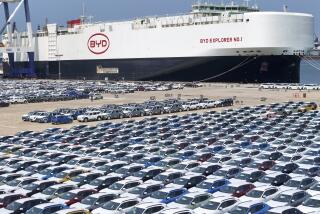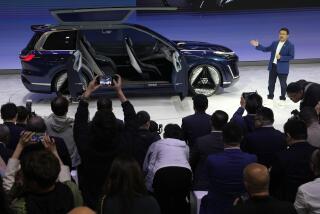Beijing to Get Look at Imported Cars : China: Country’s first showroom for foreign makes is seen as key to turning the auto into a common tool.
BEIJING — Beijing’s first public showroom for imported cars opens this week, an important step in turning the car from a tool of privilege into an ordinary commodity.
The showroom, run by Beijing CIM Automall Co., a subsidiary of the CIM Corp. of Hong Kong, will display cars by six foreign makers: Ferrari, Audi, Honda, Lancia, Volkswagen and Mitsubishi.
Wednesday’s opening will have the usual pizazz of motor marketing, elegant women draped over gleaming new cars, a lion dance, speeches by dignitaries and dozens of television and still cameras.
“We want the showroom to be a window for Chinese on the world auto market and for foreign makers on the Chinese market,” said Philip Yang, general manager of Beijing CIM.
Like other companies, foreign car makers are keenly watching the Chinese market but low incomes, a shortage of foreign exchange and limited road space have made it a limited market that till now has been strictly controlled.
For the 45 years of communist rule, imported cars have been a perquisite zealously guarded by the authorities and rationed through quotas, permits and high taxes.
A chauffeur-driven ride in an Audi or Nissan limousine or, even better, a Mercedes Benz or a BMW, has been a sign of high rank and privilege, not something bought with mere money.
In many government jobs, car privileges have been part of the package, with low officials scrambling to put bookings in at the car pool while higher-ranking cadres secure exclusive use of their own state vehicles.
But this is changing, and the showroom is part of this change. The government wants to make cars more like other commodities, so people can buy them if they have the money without elaborate approval procedures, which have been widely abused.
The Materials Ministry announced earlier this year seven policies aimed at encouraging individuals to buy cars with their own money, and reducing illegal purchases by bureaucrats using public money.
An official for the production section of the China National Auto Industry Corp. said it had become easier for individuals to buy locally made cars, with only money and an introduction letter from a company or work-unit needed.
“Buying an imported car remains more difficult and needs a license. But it is easier now than it was one or two years ago,” she said.
To normalize the market, the government on Jan. 1 lopped 70 percentage points off car import tariffs, leaving large models taxable at 150% and small and medium-sized models taxable at 110%.
While this still means that an imported Toyota can cost more than $50,000, it marked an important step toward making such cars more affordable.
Beijing also dropped a concession that enabled Sino-foreign joint ventures to bring in imported cars tax-free, a privilege widely abused by businessmen who often set up joint ventures solely for the purpose of using their car quotas.
An official of a Japanese car maker said that, in line with its application to rejoin the General Agreement on Tariffs and Trade (GATT), China is cutting the import tariffs and the paperwork needed to buy imported cars.
“But China is still short of foreign exchange, which means that it cannot liberalize the market completely,” he said.
Official figures show ownership of passenger cars in China at 1.2 million at the end of 1993, 70% of them imports, most used actually or nominally for business.
China produced 1.31 million motor vehicles in 1993, up 22.8% from 1992, of which 234,000 were cars.
Last year China officially imported 310,000 cars, up from 210,000 in 1992, with an enormous number smuggled in.
Beijing taxi drivers say that a smuggled car can be bought, complete with the necessary official forms, at a considerable discount from the price of a legal import and that officials are often involved in the racket.
The reason car ownership in China is less than 1/10 of the world average is that prices are more than double world levels while incomes are a fraction of the world average.
The average urban resident in 1993 earned $270, although incomes in major cities are several times higher, while a small number of people earn tens of thousands of yuan--or thousands of U. S. dollars--a year.
The cheapest local car is the Charade, made under a joint venture with Daihatsu of Japan and costing $10,574, while a Santana, made under a joint venture with Volkswagen of Germany, costs $18,700.
An imported Toyota Crown costs $46,000 to $56,500.






